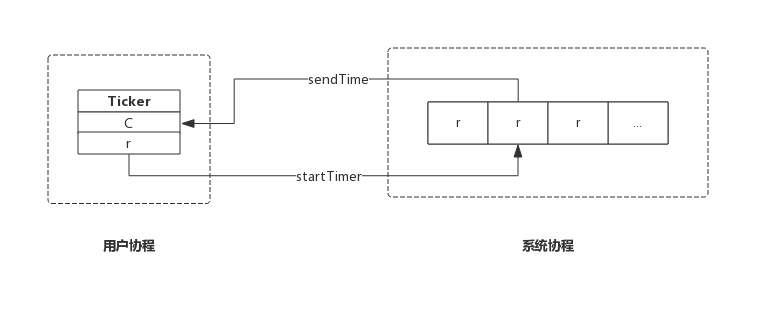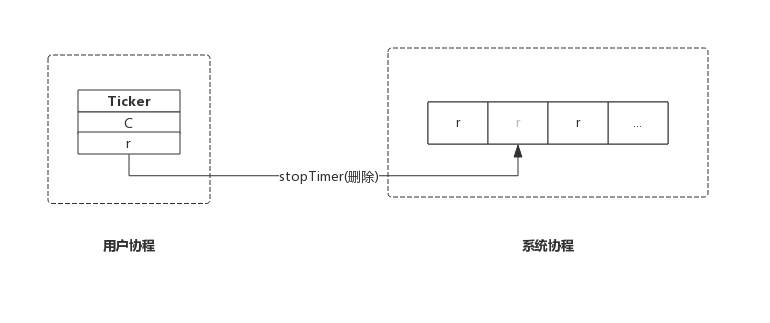## ticker实现原理
Ticker数据结构与Timer除名字不同外完全一样。
源码包`src/time/tick.go:Ticker`定义了其数据结构:
~~~go
type Ticker struct {
C <-chan Time // The channel on which the ticks are delivered.
r runtimeTimer
}
~~~
Ticker只有两个成员:
* C: 管道,上层应用根据此管道接收事件;
* r: runtime定时器,该定时器即系统管理的定时器,对上层应用不可见;
这里应该按照层次来理解Ticker数据结构,Ticker.C即面向Ticker用户的,Ticker.r是面向底层的定时器实现
### 创建Ticker
我们来看创建Ticker的实现,非常简单:
~~~go
func NewTicker(d Duration) *Ticker {
if d <= 0 {
panic(errors.New("non-positive interval for NewTicker"))
}
// Give the channel a 1-element time buffer.
// If the client falls behind while reading, we drop ticks
// on the floor until the client catches up.
c := make(chan Time, 1)
t := &Ticker{
C: c,
r: runtimeTimer{
when: when(d),
period: int64(d), // Ticker跟Timer的重要区就是提供了period这个参数,据此决定timer是一次性的,还是周期性的
f: sendTime,
arg: c,
},
}
startTimer(&t.r)
return t
}
~~~
NewTicker()只是构造了一个Ticker,然后把Ticker.r通过startTimer()交给系统协程维护。
其中period为事件触发的周期。
其中sendTime()方法便是定时器触发时的动作:
~~~go
func sendTime(c interface{}, seq uintptr) {
select {
case c.(chan Time) <- Now():
default:
}
}
~~~
sendTime接收一个管道作为参数,其主要任务是向管道中写入当前时间。
创建Ticker时生成的管道含有一个缓冲区(`make(chan Time, 1)`),但是Ticker触发的事件却是周期性的,如果管道中的数据没有被取走,那么sendTime()也不会阻塞,而是直接退出,带来的后果是本次事件会丢失。
综上,创建一个Ticker示意图如下:

### 停止Ticker
停止Ticker,只是简单的把Ticker从系统协程中移除。函数主要实现如下:
~~~go
func (t *Ticker) Stop() {
stopTimer(&t.r)
}
~~~
stopTicker()即通知系统协程把该Ticker移除,即不再监控。系统协程只是移除Ticker并不会关闭管道,以避免用户协程读取错误。
与Timer不同的是,Ticker停止时没有返回值,即不需要关注返回值,实际上返回值也没啥用途。
综上,停止一个Ticker示意图如下:

Ticker没有重置接口,也即Ticker创建后不能通过重置修改周期。
需要格外注意的是Ticker用完后必须主动停止,否则会产生资源泄露,会持续消耗CPU资源。
- 概述
- go语言基础特性
- Go语言声明
- Go项目构建及编译
- go command
- 程序设计原则
- Go基础
- 变量
- 常量
- iota
- 基本类型
- byte和rune类型
- 类型定义和类型别名
- 数组
- string
- 高效字符串连接
- string底层原理
- 运算符
- new
- make
- 指针
- 下划线 & import
- 语法糖
- 简短变量申明
- 流程控制
- ifelse
- switch
- select
- select实现原理
- select常见案例
- for
- range
- range实现原理
- 常见案例
- range陷阱
- Goto&Break&Continue
- Go函数
- 函数
- 可变参数函数
- 高阶函数
- init函数和main函数
- 匿名函数
- 闭包
- 常用内置函数
- defer
- defer常见案例
- defer规则
- defer与函数返回值
- defer实现原理
- defer陷阱
- 数据结构
- slice
- slice内存布局
- slice&array
- slice底层实现
- slice陷阱
- map
- Map实现原理
- 集合
- List
- Set
- 线程安全数据结构
- sync.Map
- Concurrent Map
- 面向对象编程
- struct
- 匿名结构体&匿名字段
- 嵌套结构体
- 结构体的“继承”
- struct tag
- 行为方法
- 方法与函数
- type Method Value & Method Expressions
- interface
- 类型断言
- 多态
- 错误机制
- error
- 自定义错误
- panic&recover
- reflect
- reflect包
- 应用示例
- DeepEqual
- 反射-fillObjectField
- 反射-copyObject
- IO
- 读取文件
- 写文件
- bufio
- ioutil
- Go网络编程
- tcp
- tcp粘包
- udp
- HTTP
- http服务
- httprouter
- webSocket
- go并发编程
- Goroutine
- thread vs goroutine
- Goroutine任务取消
- 通过channel广播实现
- Context
- Goroutine调度机制
- goroutine调度器1.0
- GMP模型调度器
- 调度器窃取策略
- 调度器的生命周期
- 调度过程全解析
- channel
- 无缓冲的通道
- 缓冲信道
- 单向信道
- chan实现原理
- 共享内存并发机制
- mutex互斥锁
- mutex
- mutex原理
- mutex模式
- RWLock
- 使用信道处理竞态条件
- WaitGroup
- 工作池
- 并发任务
- once运行一次
- 仅需任意任务完成
- 所有任务完成
- 对象池
- 定时器Timer
- Timer
- Timer实现原理
- 周期性定时器Ticker
- Ticker对外接口
- ticker使用场景
- ticker实现原理
- ticker使用陷阱
- 包和依赖管理
- package
- 依赖管理
- 测试
- 单元测试
- 表格测试法
- Banchmark
- BDD
- 常用架构模式
- Pipe-filter pattern
- Micro Kernel
- JSON
- json-内置解析器
- easyjson
- 性能分析
- gc
- 工具类
- fmt
- Time
- builtin
- unsafe
- sync.pool
- atomic
- flag
- runtime
- strconv
- template
